Stamp On History
Content from 2006 - 2009
The Stamp on History was an educational website exploring the lives of famous figures through their pictures on US Postage stamps.
Content is from the site's 2006 - 2009 archived pages providing just a glimpse of what this site offered its visitors.
Actors and Entertainers
Artists, Architects, and Designers
Athletes and Coaches
Aviators
Doctors and Nurses
Explorers
Inventors
Lawyers and Judges
Musicians
Political and Military Leaders
Scientists
Social Activists and Philanthropists
Writers
~~~~~
AN ASIDE: I use to visit this site when I was a kid and collecting stamps- not these types of stamps, but the stamps from letters or postcards that were sent to me by my father and relatives when they were in various countries outside the US. I still have my stamp collection scrapbook from those days. Along with the numerous stamps I have a few photographs of me holding up the scrapbook. Recently showed my girlfriend the scrapbook and she remarked that I still wear similar glasses frames to those I wore as a kid. Sure enough, the frames are similar, but the way I now buy prescription glasses is so different. I no longer go to the local optometrist with prescription in hand to order new frames and prescription lens. Instead I buy my glasses or just replace my prescription lenses online at Eyeglasses.com. As far as stamps are concerned, I still collect them, but my boyhood obsession has resulted in my becoming a professional dealer. I assist collectors in connecting with others in order to buy, sell, and exchange stamps. If you seriously collect stamps, I would suggest learning more about the American Philatelic Society, the world’s largest collection of global philatelic literature. Along with their extensive digital library of material, the American Philatelic Research Library is the most comprehensive resource for philatelic content. And whether you need beginner tips or are conducting groundbreaking research, the APS Education Department offers a variety of useful programs.
Welcome!
Welcome to Their Stamp on History! Since the first stamps featuring George Washington and Benjamin Franklin in 1847, the United States has been honoring great Americans through their pictures on postage stamps. Their Stamp on History tells the stories of these men and women with biographical information, links for kids to explore further, and lesson plan resources for teachers and parents.
Writers
Edith Wharton (1862-1937)

Edith Wharton was an American writer, associated with the “Gilded Age” of United States history. She was a member of the wealthy, upper-class society that developed in the period after the Civil War and many of her novels offer insight into that world.
Wharton was born Edith Newbold Jones on January 24, 1862. Her parents were well-to-do New Yorkers with society connections. When Edith was a young girl, they moved to Europe for several years. Edith was educated at home by private tutors and through her own reading. She began writing at a young age, with her first works being published when she was still a teenager.
In 1885, Edith married an investment banker named Edward Wharton. Like the Jones family, the Whartons travelled extensively in Europe, although they never had any children. Unfortunately, their marriage wasn’t a happy one and the two divorced in 1913.
Wharton settled in France after her divorce and, during World War I, wrote reports for American newspapers. She continued to write books, publishing more than 40 volumes of fiction and poetry. She became good friends with the author, Henry James.
Some of Wharton’s most famous books were The House of Mirth, The Age of Innocence, and Ethan Frome. She was the first woman ever to win a Pulitzer Prize for fiction and the first woman granted an honorary degree by Yale University.
Edith Wharton died of a stroke in 1937. This commemorative stamp was issued in 1980.
Theodor Seuss Geisel (1904-1991)

He’s Theodor Geisel
But Seuss is just fine
The thing about Geisel—It’s too hard to rhyme!
The man known everywhere as Dr. Seuss was neither a doctor, nor was his last name Seuss. Theodor “Ted” Seuss Geisel was a second-generation German-American (the grandson of immigrants), born in Springfield, Massachusetts on March 2, 1904.
Ted’s family brought the craft of beer brewing with them from Germany and were quite successful until the onset of Prohibition (when alcohol became illegal in the United States) and World War I (when the US fought against Germany). Those years were difficult for the family, but they survived and remained vocally in support of America during the war.
Geisel published his first cartoon when he won a contest at the age of twelve. He drew cartoons and wrote jokes during high school. While attending Dartmouth University, he became the editor of the school’s humor magazine, The Jack-O-Lantern. He was fired from the job and told he couldn’t write for the magazine at all anymore when he and his friends threw a party that violated school rules. Geisel kept writing anyway, but he signed his articles using his middle name a pseudonym: Seuss.
After Dartmouth, Geisel attended Oxford University, where he met his future wife, Helen. Over the next years, he created many political cartoons and considered becoming a college professor. His wife suggested that he might do better as a cartoonist.
In 1937, he wrote his first children’s book, And To Think That I Saw It On Mulberry Street. It was rejected 27 times before finally being published by an old friend Geisel knew from Dartmouth. The book was a hit. Dr. Seuss followed it up with The Cat in the Hat, a book designed with 220 vocabulary words to help kids learn to read. His book, Green Eggs and Ham uses only 50 words!
Geisel married his second wife, Audrey, in 1968 after Helen passed away. Before his death in 1991, he wrote more than 40 books for children and adults. Schools across the country still celebrate Read Across America Day every March 2 on Dr. Seuss’s birthday.
Dr. Seuss’s stamp was issued on March 2, 2004.
Dorothy Parker (1893-1967)

Dorothy Parker, writer and member of the Algonquin Round Table.
Dorothy Parker is one of the few American writers as well known for their personalities as for their writing. She’s been called witty, wry, acerbic, and acid-tongued for her sharp, pointed remarks and quick comebacks.
Parker was born Dorothy Rothschild in West End, New Jersey. In her mid-20s, she sold her first poems and quickly became a mainstay of New York intellectual society. A year after her first publication, she became a drama critic for Vanity Fair. There, she began a long friendship with two other writers, Robert Sherwood and Robert Benchley.
Parker, Sherwood, and Benchley, along with several other writers of the 1920s formed a group known as the Algonquin Round Table. Meeting regularly at the Algonquin Hotel in New York, they became famous for their intellectually elite membership and witty repartée.
Parker went on to write several volumes of poetry, short story collections, plays, and critically-acclaimed screenplays.
Edna St. Vincent Millay (1892-1950)

Edna St. Vincent Millay, lyrical poet and playwright.
Edna St. Vincent Millay was a lyrical poet and playwright of the early 20th century.
Millay, called “Vincent” in her growing-up years, spent her early life in a single-parent family with her mother and sisters. The family was a cultured one, immersed in music and literature, and Millay was an accomplished writer at an early age. One of her most famous poems, “Renascence,” won an award and publication in a literary contest before she even began college.
Millay’s college years, funded by a scholarship at the all-women’s Vassar, produced the book The Harp Weaver and Other Poems for which she won a Pulitzer prize in 1922.
Edna St. Vincent Millay is known for the feminism and sexual openness expressed in many of her poems. She was married in 1923 to Eugen Boissevain, a feminist himself, but the marriage was an open one. Throughout her life, Millay carried on affectionate correspondences with both men and women.
Millay died in 1950 of heart failure.
Leaders
Robert E. Lee (1807-1870)

This brilliant military leader faced a grueling decision at the outbreak of the Civil War.
In the southern U.S., it’s hard to find a historical figure more revered than General Robert. E. Lee. A gifted military strategist, Lee gave up his commission in the United States Army during the Civil War to fight for his friends and family in the Confederate South.
Lee was born in Virginia in 1807. He was the fifth child of six born to Henry “Light Horse Harry” Lee III and Ann Hill Carter. “Light Horse Harry” was a Revolutionary War hero, who also served as Virginia governor and a member of Congress.
Robert E. Lee went to school at the prestigious military academy at West Point, where he graduated second in his class. Lee served in the United States Army from 1829 until 1861. During that time, he fought in the Mexican War, served as superintendent at West Point, and became a colonel in the U.S. Cavalry, a unit of soldiers who fought from horseback. He also married Mary Custis and had seven children, who spent much of their time at the family plantation, Arlington House.
In 1861, the state of Virginia, where Lee had grown up, seceded from the Union and Lee found himself faced with a choice between the land where his family had lived for generations, and the country he’d served for 32 years. He chose his friends and family. Though he was a loyal servant to the United States and morally opposed to slavery, he was more loyal to his roots in Virginia. On April 20, 1861, Lee resigned his commission in the U.S. Army to take command of the military and naval forces of Virginia. Later, he became Brigadier General of the Confederate Army, the army of all the seceded southern states.
During the years of the Civil War, Lee became a much-beloved general who led a brilliant campaign. The Confederate Army was smaller than the Union Army, with less training, less equipment, and less resources, yet Lee managed to eke out victories against all odds. By 1865, however, Lee realized the Confederate Army could no longer stand. To avoid more considerable losses, he surrendered to General Ulysses S. Grant at the Appomattox Court House on April 9.
After the war, Lee encouraged reconciliation for ex-Confederates and eased the transition back to a united country. Upon his retirement from military service, he assumed the presidency of Washington College, which is now called Washington and Lee University.
Lee has been honored twice on U.S. postage stamps. The release here shows him in his Confederate uniform. Just visible behind him is his favorite horse, Traveller.
Sequoyah (c. 1776-1843)

A man whose name meant “Pig’s Foot” in his native language created the first system for writing that language.
Sequoyah gave written language to the Cherokee tribe by developing an alphabet to express his native language.
He was the son of a Cherokee woman named Wut-Teh and an English fur trader named Nathaniel Gist. Sequoyah was named George Gist by his father, but he’s better known by his Cherokee name, which means “pig’s foot.” He was called this because he was disabled (either from birth or from a hunting accident at a young age).
Sequoyah was born in the Cherokee village of Tuskegee, on the bank of the Little Tennessee River, but he eventually moved to Georgia and later, Arkansas. He married a Cherokee woman, learned silversmithing skills, and had a daughter named Ayoka.
Like many of his people, Sequoyah enlisted in the Army to fight with the United States in the War of 1812. He and the other Cherokees couldn’t write letters home because the Cherokee language was only spoken, not written. The English-speaking soldiers could convert their language into what the Native Americans called “talking leaves” and Sequoyah became obsessed with the idea of creating a similar system for Cherokee.
After twelve years of work and practicing the writing system with his daughter, Sequoyah presented his new alphabet (called a “syllabary”) to the tribal elders. The Cherokee Nation adopted the system as their own in 1821 and, within only a few years, thousands of Cherokees learned to read and write for the first time.
Sequoyah acted as a diplomat and statesman for the Cherokee people until he died in 1843 on a trip to Mexico.
Harriet Tubman (c.1821-1913)

Harriet Tubman, director on the Underground Railroad.
Harriet Ross was born into a Maryland slave family between 1819 and 1821 and named for her mother and father. By the time of her death in 1913, she was well known as an abolitionist, Civil War volunteer and humanitarian.
As a child, Harriet lived under cruel conditions, suffering her whole life from the repercussions of beatings by a white overseer. In her mid-20s, she married a freed slave, John Tubman, but fearing being sold, she escaped via the Underground Railroad just five years later.
After her successful escape, Harriet Tubman resolved to return to Maryland to help the rest of her family make their way to freedom in Canada. Over the course of the next several years, she made 18 trips to the South and directed more than 300 slaves through the Underground Railroad. No slave was ever captured or killed on her watch.
During the Civil War, Tubman served as a nurse, scout, and spy for the Union Army. When the war was over, she settled in Auburn, New York and founded a home for the poor and elderly. She was also active in the early movement for women’s rights.
Harriet Tubman died in 1913. She was buried with military honors.
John Hanson (1715-1783)

John Hanson, Maryland senator and patriot who played a pivotal role in early United States politics.
John Hanson was a Maryland senator and patriot who played a pivotal role in early United States politics.
Hanson was born to a landed family in Charles County, Maryland in 1715. Like many of the early American patriots, he was both an academic and a farmer. In 1757, Hanson began the first of his nine terms in the Maryland State senate.
The senator supported the American colonies’ armed resistance against the British and, when the American Revolution was won, he was elected to the Continental Congress. In 1781, Hanson signed the Articles of Confederation, the document that established the first United States government. Hanson was instrumental in the acceptance of the Articles. As the representative from Maryland, he worked to convince larger states to give up their western land holdings, thereby leveling the playing field and making the Articles more appealing to smaller states.
As a result of his work, Hanson was chosen unanimously to become the first U.S. President under the Articles of Confederation. During his one-year term, he ordered all foreign troops off of U.S. soil, established the Treasury and Foreign Affairs departments, and declared the fourth Thursday of November to be a national holiday – Thanksgiving.
Hanson is not remembered as the first U.S. president because the Articles of Confederation proved to be flawed. They were dropped in favor of the United States Constitution in 1789. Hanson would not see this new system of government. He died in 1783 at the residence of his nephew in Maryland.
Scientists
Rachel Carson (1907-1964)

Rachel Carson, environmentalist and author of Silent Spring.
There can be no overstating Rachel Carson’s influence on the modern environmental movement. With the 1962 publication of her book, Silent Spring, she ignited a storm of controversy that grew into a national discussion on the effects of chemicals on the environment and the humans who live in it.
Rachel Carson was born in Springdale, Pennsylvania, a small rural town where she was able to spend her childhood enjoying the outdoors in a relatively unspoiled environment. Her mother, Maria McLean Carson was a big influence on Rachel’s early life, encouraging her love of nature and her interest in books and writing.
Carson’s youthful interests continued into her college years at Pennsylvania College for Women, where she abandoned her original intention of studying English to pursue a degree in zoology. She graduated with high honors in 1928 and continued her studies in marine biology at Johns Hopkins University.
After receiving her masters degree, Carson began a sixteen-year career with the United States Bureau of Fisheries. There, she wrote brochures and broadcast material on topics ranging from conservation to fish as a food source. This material provided the basis for the more poetic writing she did outside of the Bureau. Her first book, Under the Sea Wind, was published in 1941. It was followed by two more, The Sea Around Us (1951) and The Edge of the Sea (1955), before her 1962 masterpiece, Silent Spring.
While her first three books had been imbued with a sense of wonder at the underwater world, Silent Spring contained a more sobering message. Carson’s research revealed that the use of chemical pesticides such as DDT was responsible for a host of serious problems, including genetic defects, animal poisoning, and human illness. Because of its controversial message, the publication of Silent Spring was met by both glowing reviews (by the country’s scientific elite) and scathing attacks (by the chemical industry.)
Carson responded to the criticism leveled at her by speaking out to Congress and various organizations. A year after Silent Spring, President Kennedy’s Science Advisory Committee confirmed the book’s message. Carson continued her environmental activism until her death of breast cancer in 1964. She is now considered one of the most important scientific voices of the twentieth century.
Ernest E. Just (1883-1941)

Ernest Everett Just was a talented biologist and professor in an era when African American academics were routinely turned away from positions in American universities. His most famous work was a book called The Biology of the Cell Surface.
Musicians
Rosa Ponselle (1897-1981)
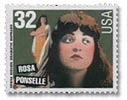
One of the greatest operatic sopranos of all time was first discovered singing in a vaudeville show with her sister.
Rosa Ponselle was an opera singer said to be one of the greatest soprano voices of all time.
Ponselle was born in Connecticut with the name Rosa Ponzillo. When she was young, she and her older sister, Carmela, sang in vaudeville shows together. Vaudeville was a popular entertainment in the early 1900s in which a variety of different types of acts performed at the same show. Carmela and Rosa called themselves The Ponzillo Sisters.
In 1921, Ponselle was discovered on the vaudeville stage by the opera singer, Enrico Caruso. He brought her to the New York Metropolitan Opera, “the Met,” to sing opposite him. Ponselle was the first American singer to perform a major role at the Met without having gone to Europe for voice training. She was a natural talent with a rich, beautiful voice.
Ponselle performed many roles at the Met from the age of 21 until about 40. Then, she gave one last performance of Carmen, and never appeared on stage again. She stayed involved with the opera world, singing for friends, recording albums, and training new talent for the next 44 years.
Ponselle died in 1981. Another great soprano, Maria Callas, called her “simply the greatest singer of us all.” Ponselle’s stamp was released on January 22, 1997, the one hundredth anniversary of her birth.
Duke Ellington (1899-1974)

Duke Ellington, jazz musician and bandleader.
A profound influence on American jazz music, Duke Ellington’s career as a pianist, bandleader, and composer spanned more than fifty years.
“Duke” Ellington was born Edward Kennedy Ellington, the child of a Washington D.C. couple, Daisy Kennedy Ellington and James Edward Ellington. Though he took piano lessons as a child, Ellington’s original career choice was commercial art.
It was while he was in art school that Ellington rediscovered the piano. Three months shy of graduation, he dropped out to begin his professional music career. His first band, The Duke’s Serenaders, played in and around Washington D.C. until 1923.
That year, Ellington and his band left Washington D.C. for New York City, where they renamed themselves The Washingtonians and quickly gained a reputation through radio play and recordings. In 1927, his band became the house band at the Cotton Club, an exclusive white nightclub that showcased the best black entertainers of the era.
Ellington’s hits included “Satin Doll”, “Mood Indigo,” “The Mooche,” and many others. The music was groundbreaking, with harmonies and intervals never used before in popular music.
Duke Ellington continued performing until his death in 1974.
Roberta Martin (1907-1969)
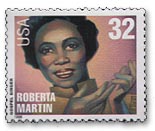
Roberta Martin, founder of the Roberta Martin Singers and pioneer of modern gospel music
Athletes
Roberto Clemente (1934-1972)

The first Latin American elected to the Baseball Hall of Fame died while coordinating earthquake relief for Nicaragua.
By almost any account, Roberto Clemente is among the greats of baseball history. He was the first Latin American player elected to the baseball Hall of Fame and is celebrated for his humanitarianism as well as his athleticism.
Born on August 18, 1934 in Puerto Rico, Clemente was signed by the Brooklyn Dodgers shortly after his graduation from high school. The Dodgers originally sent Clemente to play for their Montreal club, but Major League Baseball rules stipulated that anyone with a contract as large as Clemente’s would be available for draft if they didn’t remain on the parent club’s roster for a full season. As a result, he was quickly drafted away from the Dodgers by the Pittsburgh Pirates.
Clemente played right field for the Pirates for 18 years, batting above .300 for 13 seasons and making 3000 career hits. The height of his career came in 1971 when he led his team to a World Series victory and took home the MVP trophy.
In December of 1972, a catastrophic earthquake hit Managua, Nicaragua. As neighboring countries and aid organizations worked to coordinate relief efforts, reports of corruption in the Nicaraguan government and the misdirection of supplies reached Clemente. He determined to organize his own relief mission and personally coordinate the delivery of goods. On December 31, 1972, Clemente boarded a DC-7 loaded with 16,000 pounds of cargo. The plane never reached its destination. Roberto Clemente died in the crash off the coast of Puerto Rico.
The Baseball Writer’s Association of America waived the usual 5 year waiting period for Hall of Fame membership and inducted Clemente the very next year.
Paul Robeson (1898-1976)
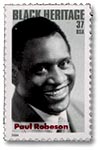
“Old Man Winter” was just the tip of the iceberg for this multi-talented Renaissance Man.
Jackie Robinson (1919-1972)

On April 15, 1947, the first African American to play in a major league baseball game in over a century stepped onto the field. Before the Army was desegregated, before black and white children began attending public school together, and …
Babe Zaharias (c.1911-1956)
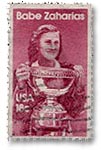
Professional golfer and and all-around athlete.
Babe Didrikson Zaharias was good at every sport she tried… and she tried a lot of sports. She played basketball, tennis, football, billiards, golf, softball, and polo, just to name a few. She ran track and field, she swam, and she bowled. Unquestionably, Babe Zaharias was one of the most talented female athletes the world has ever seen.
Born Mildred Ella Didriksen in 1911, Babe Zaharias was an unabashed tomboy. In high school, she played basketball, one of very few options for girls at the time (many schools didn’t have any sports for girls at all.) In 1930, she took up track and field training and qualified for the 1932 Olympics, where she won two gold medals and one silver (due only to a judging technicality.)
Throughout her career, Didrikson was often criticized by the public and the press for appearing too “mannish.” As her fame grew, she made a concerted effort to appear more feminine, often speaking in interviews about traditionally female pursuits, and making herself over to fit society’s standards for how women should look. In 1938, she married George Zaharias, a professional wrestler, and added his last name to her own.
Babe Zaharias’ most famous role was as a golfer in the the 1930s, 40s, and 50s. She won thirteen consecutive amateur tournaments in 1946 and later, became one of the first professional female golfers of the LPGA. In 1948, she won the U.S. Women’s Open, the World Championship and the All-American Open.
In 1953, Zaharias was diagnosed with cancer. Although she staged an incredible comeback to win her third U.S. Women’s Open only fourteen weeks after surgery to remove her tumor, the disease eventually defeated her. She died on September 27, 1956.
Actors / Entertainers
Alvin Ailey (1931-1989)

American dancer and choreographer.
Alvin Ailey was an American dancer and choreographer who founded the Alvin Ailey American Dance Theater (AAADT), a modern dance company that still performs his compositions today.
Ailey was born in Rogers, Texas in 1931. His parents separated when he was very young and Ailey and his mother moved a lot, though they stayed in the South until 1932, when they relocated to Los Angeles. Ailey was in high school when a friend convinced him to begin studying dance with the Lester Horton Dance Theatre in 1949.
Horton died in 1953, leaving his dance company without an artistic director. At only twenty-two years old, Ailey took on the responsibility and began choreographing for the first time. A year later, he and his friend were invited to perform in a Broadway show called House of Flowers and they moved to New York City.
The move to New York brought Ailey in contact with such modern dance teachers as Martha Graham, Doris Humphrey, Charles Weidman, and Karel Shook, but he eventually decided to start his own company to showcase the kind of dance technique he preferred—a style that included techniques from Horton and Graham, as well as African dance, Oriental dance styles, and classical ballet.
The Alvin Ailey American Dance Theatre was founded in 1958 with seven dancers. In 1960, Ailey debuted his work, “Revelations,” a dance that portrayed the African-American experience, set to spiritual and gospel music. Though many of Ailey’s pieces draw on African-American culture, it was important to Ailey that the AAADT was always integrated, with dancers of many different races.
In the 1960s, the AAADT was sponsored by the U.S. State Department to conduct a tour of Southeast Asia and Australia. Since that time, they’ve performed in countries around the world. Their repertory now includes over 200 works by over 70 choreographers.
Ailey choreographed 79 ballets over his lifetime, including pieces for the American Ballet Theater, the Metropolitan Opera, the Joffrey Ballet, the Paris Opera Ballet, the London Festival Ballet, and the Royal Danish Ballet. He died in 1989 after a long illness.
Alvin Ailey’s stamp was issued in 2004 as part of the American Choreographers series.
Marilyn Monroe (1926-1962)

Foster child Norma Jeane Mortensen became the glamorous icon, Marilyn Monroe.
Marilyn Monroe’s life didn’t begin anywhere close to as glamourous as it looks in pictures. The woman known for her blonde hair, red lipstick, and skin-tight dresses started out as a brown-haired girl named Norma Jeane Mortensen.
Norma Jeane never knew her father and her mother suffered from mental illness, so she spent much of her childhood an orphanage and various foster homes. She got married for the first time at the age of sixteen to a man named Jim Dougherty. During World War II, Dougherty joined the Army and was sent overseas and Norma Jeane went to work in an airplane factory.
In 1945, a photographer came to the plant and took some pictures of the women working there, including Norma Jeane. She ended up on the cover of a magazine called Yank and began to be offered other modeling jobs.
Norma Jeane divorced her husband the next year as she began to think about an acting career. She signed a contract with the movie studio, Twentieth Century Fox, dyed her hair blonde, and changed her name to the more movie-star-like “Marilyn Monroe.”
Over the next years, Monroe married twice more, once to baseball player Joe DiMaggio and once to playwright Arthur Miller. Both marriages ended in divorce. She appeared in over thirty movies, including Gentlemen Prefer Blondes, Some Like It Hot, and The Seven Year Itch. One of her most memorable moments came when she sang “Happy Birthday” to President John F. Kennedy.
On August 5, 1962, Marilyn Monroe died of an overdose of pills. She was only 36 years old.
Marilyn Monroe’s stamp was issued on her birthday (June 1) in 1995.
Humphrey Bogart (1899-1957)

Humphrey Bogart, “tough guy” actor who starred in films such as Casablanca and The Maltese Falcon.
Reports as to Humphrey Bogart’s birthdate vary. Some say it was on Christmas Day 1899. Others dismiss that date as a Hollywood myth and put the true date on January 23, 1899. Regardless of the date he came into the world, Humphrey Bogart left it as one of the most famous actors of his generation.
Despite an upper-class New York upbringing, Humphrey Bogart rejected plans for an Ivy League education and medical school by enlisting in the U.S. Navy in 1918. His military career, though short, probably provided the inspiration for many of the characters he would play later in life.
Bogart turned to acting after his discharge from the Navy, serving as an office boy before becoming a stage manager and eventually taking a variety of small theatrical roles.
In 1930, he decided to leave Broadway and try his luck at movie acting. In Hollywood, Bogart’s first feature film was a failure called The Devil With Women. Unfortunately, it wasn’t to be his only failure and after several more doomed movies, he returned to New York and his roots on the stage.
It was back in New York that Bogart finally found fame. His lead role in The Petrified Forest was a great success. He was later asked to play the lead in the film version. Released in 1936, The Petrified Forest was even more successful as a film than as a play.
From that point on, Bogart gained a reputation as a movie tough guy. His unique take on the stereotypical character type made him a hit with both men and women. He starred in such classic films as The Maltese Falcon, Casablanca, and The African Queen and with leading ladies Bette Davis, Ingrid Bergman, Katherine Hepburne, and Lauren Bacall (who became his wife).
Humphrey Bogart won a best actor Oscar in 1952 for his role as Charlie Allnut in The African Queen. He continued acting until his death in January 1957 from complications of throat cancer.
Lon Chaney (1883-1930)
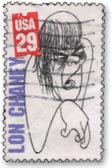
Lon Chaney, silent movie actor dubbed “The Man of a Thousand Faces”
Artists
James Hoban (c.1762-1831)

James Hoban was already an established architect when he entered a contest to design a home for the new President of the United States in 1792. He had begun his career in Ireland, graduating from the Dublin Society School and …
James Hoban was already an established architect when he entered a contest to design a home for the new President of the United States in 1792. He had begun his career in Ireland, graduating from the Dublin Society School and then made a name for himself in Philadelphia after emigrating to the young United States.
Hoban won the design contest with a design that included two stories and a raised basement. Before it was built, the White House was reduced to two stories, with the lower floor meant for entertaining guests and the upper floor designed to house the President and his family.
From 1793 to 1800, Hoban oversaw the construction of the White House, the largest residence in the country at the time. In November, 1800, John and Abigail Adams became the first President and First Lady to live in the house.
Hoban was called in to work on the White House again in 1814 after the British burned the building in the War of 1812. The building was rebuilt exactly as it had been before as a sign of the permanency of the American government.
Over the years, the White House has been expanded to include new floors, wings, and porticoes, but Hoban’s original design has remained essentially unchanged. It is one of the most recognizable buildings in the world and a National Historic Landmark in the United States.
Hoban died in 1831.
Frida Kahlo (1907-1954)

If you were to ask her, Frida Kahlo would tell you she was born in 1910, the year the Mexican Revolution began. Her birth certificate, however, read “July 6, 1907.” Though she wasn’t truly born in the same year as the new Mexico, Kahlo’s life, art, and identity were inseparable from her Mexican culture. She was known for dressing in the traditional Mexican style of long, colorful dresses, woven shawls, and bright flowers or elaborate jewelry. The same color palette and themes of cultural identity can be seen in her art.
Frida Kahlo’s life was marked by tragedy. At a young age, she was stricken with polio, which left one of her legs thinner and weaker than the other. In 1925, she was involved in a crippling bus accident. Kahlo’s body was pierced by a metal pole and she broke several bones, including her foot, spine, and pelvis. Although she eventually regained her ability to walk, Kahlo suffered from repercussions of this accident for the rest of her life. She had more than 30 operations, was bedridden for long periods, and dealt with chronic bouts of pain until her death.
In 1929, Kahlo married Diego Rivera, a famous Mexican muralist. The two artists had a passionate and difficult relationship, documented in Kahlo’s numerous self-portraits. Due to her accident, Kahlo was unable to carry a pregnancy to term, a source of great sadness to her. Both Kahlo and Rivera had many extramarital affairs – Rivera’s included one with Kahlo’s own sister. The couple divorced in 1939, but later remarried and remained together for the remainder of her life.
Kahlo and Rivera spent several years in the United States, traveling and exhibiting their work. Frida Kahlo never had a solo exhibit in Mexico until 1953, a few years before her death. She attended the showing despite being bedridden. Her four-poster bed was transported to the National Institute of Fine Arts in Mexico City for the occasion.
Frida Kahlo died in 1954. Over 200 paintings chronicle her life.
Mary Cassatt (1844-1926)

Mary Cassatt, American Impressionist painter.
Doctors and Nurses
Clara Maass (1876-1901)

Clara Maass, first nurse ever to be honored on a United States postage stamp.
Clara Maass, born in East Orange, New Jersey in 1876, was the first nurse ever to be honored on a United States postage stamp.
Maass was thrust into a caring role from early in life. She was the oldest of ten children of German immigrant parents. While in high school, she worked as a mother’s helper to help support her large family. At 15, she began working at the Newark Orphan Asylum and, two years later, the 17-year-old enrolled in the Christina Trefz Training School of Nurses at Newark German Hospital. At the age of 21, only a few years after her graduation, Maass was named head nurse of the school.
Maass left her post at Newark German Hospital in April 1898 to volunteer as a contract nurse at the outbreak of the Spanish-American War. Her two terms of service took her to Florida, Georgia, Cuba, and the Phillipines, where battle wounds took a backseat to deadly diseases like yellow fever, typhoid fever, and malaria.
In 1900, the Army began a series of yellow fever experiments at Las Animas Hospital in Havana, Cuba. By this time, it was known that yellow fever was transmitted by infected mosquitoes. Major William C. Gorgas and Dr. John Guiteras hoped to prove that by inducing a controlled case of the disease from a mosquito bite, they could treat the light illness and help patients develop an immunity. In the hopes of aiding medical science, Clara Maass volunteered to be bitten.
Maass received seven bites from infected mosquitoes over the course of several months. Her last exposure took place on August 14, 1901. Shortly afterwards, she grew ill. On August 24, 1901, Maass died of yellow fever. The experiments had demonstrated that bites from infected mosquitoes could not safely induce immunity from yellow fever. Clara Maass was the only woman and the only American to die in Gorgas’ and Guiteras’ yellow fever experiments.
Mary Walker (1832-1919)

Dr. Mary Walker, Civil War Surgeon and first female Medal of Honor recipient
Mary Breckinridge (1881-1964)
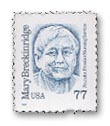
For years, Mary Breckinridge and her staff of trained nurse midwives could be found traveling through the Appalachian mountains on horseback to deliver babies and offer medical care to the families of eastern Kentucky.
